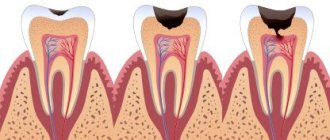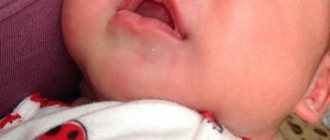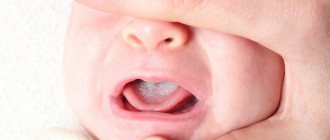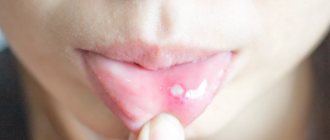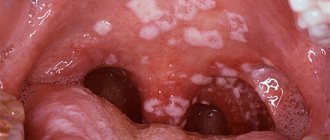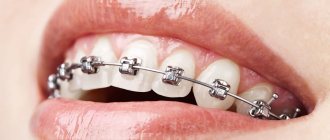Question No. 1. What causes the problem
Do you have white spots on the mucous membranes of your mouth? You need to understand that this in itself is not a disease. As a rule, this is a sign indicating some kind of pathology.
Injuries
The most common reason why a white spot appears in the mouth is injury to the delicate mucous membrane. Absolutely anyone who prefers irritating foods can get tissue damage: hot, spicy, sour, salty, hard foods. Or, for example, he brushes his teeth aggressively and incorrectly.
A white spot in the mouth is often found by smokers and those who abuse alcohol.
If there is a white spot on your cheek inside your mouth, then you may have recently accidentally bitten your cheek. By the way, this is a very common problem, you can read about it in more detail in the feature article on the site.
Smokers often experience these symptoms
Diseases
Sometimes white spots on the cheek, palate and mucous membranes of the mouth are a sign of the following diseases of the body: measles, candidiasis, herpetic and aphthous stomatitis, leukoplakia, lichen planus, cancer of the gums and oral cavity, syphilis, tonsillitis, pharyngitis, tuberculosis. They may also indicate vitamin deficiency, pathologies of internal organs (liver, kidneys1).
White spots may indicate leukoplakia
Allergy
The sign may indicate an allergic reaction that occurs due to the use of various medications, food, the use of inappropriate cosmetics and personal hygiene.
The white spot may be an allergic reaction
“A white spot somehow formed on the inside of my cheek, which itched terribly. Coincidentally, not long before this I started using a new toothpaste and mouthwash from the same series. I immediately thought it was an allergy. And exactly! As soon as I put these funds aside, everything went away in 3 days. A few months later I decided to try again, and voila, everything came back! But I know my body, because I’m always allergic to something, I always keep antihistamines on hand.”
FoxY, review from the dental portal gidpozubam.ru
Also in the section
Warts are benign neoplasms of viral origin. Two types of warts may appear on the oral mucosa: flat and.
Meteorological cheilitis is an inflammatory disease of the lips, the development of which is caused by a variety of meteorological factors.
Hereditary disorders of the development of dental tissues can affect enamel, dentin, or both. They usually arise due to hereditary influences.
Dental caries is a multifactorial pathological process that appears after teething, characterized by focal demineralization of hard tissues.
In the treatment of periodontal diseases, various physiotherapeutic methods are used: electrotherapy, ultrasound, aerosol therapy, light therapy.
Acute inflammation of the periodontium of temporary and permanent teeth in children is clinically manifested by the same symptoms that are characteristic of an exacerbation of any of the forms.
The most common cause of periodontitis in permanent teeth is dental caries. Microbes and their metabolic products lead to inflammation and...
Chronic fissure of the lip is a chronic disease of the red border of the lips, the mucous membrane of the lips and the corners of the mouth, accompanied by a linear violation of the integrity.
We suggest you read: Aching pain and aching in the teeth and jaw: reasons, what to do if a tooth aches
Periodontium is a complex of tissues surrounding the tooth (gingiva, circular ligament of the tooth, alveolar bone and periodontium), closely related anatomically and functionally. WHO.
Microglossia is a condition of the tongue accompanied by its reduction. It can be primary (congenital) or secondary (acquired). Considered to be primary.
Video consultations
When using the site materials reference to the site is required.
The EUROLAB™ trademark and trademark are registered. All rights reserved.
Question No. 2. Who is at risk
Experts believe that the risk of getting a white spot on the oral mucosa increases in the following groups of patients:
- people with weakened immunity and hormonal imbalance: here the champions for white spots in the mouth of any etiology are pregnant and breastfeeding women, elderly people, children,
- smokers: tobacco smoke, constantly in contact with the mucous membrane, can cause burns and tissue damage, provoke leukoplakia2 (precancerous condition) and other dangerous dental problems that cause white spots to appear in the mouth,
- all those who experience dry mucous membranes and lack of saliva (xerostomia): the problem can develop as a result of chronic diseases of the body (for example, diabetes mellitus),
- patients who violate oral hygiene and do not want to solve dental problems for a long time,
- allergy sufferers.
Question No. 3. Is it possible to diagnose the cause of the problem yourself?
As mentioned above, a symptom may indicate various local problems in the oral cavity, as well as internal diseases of the body. However, if you carefully examine the location of the tumor and pay attention to the accompanying signs, then preliminary conclusions can still be drawn.
The stain is located on the gum next to the tooth
When there is a white spot in your mouth on the gum next to a tooth that hurts and is very similar to a pimple (pus can even come out of it), then it is very likely that you are reaping the benefits of a long course and neglect of dental diseases such as deep caries , pulpitis, periodontitis. A white spot in the mouth on the gum can be a symptom of a fistula, gumboil, abscess, cyst and large granuloma.
The photo shows the flux
Such a symptom does not always occur only next to teeth that have not been treated. The sore can be localized near the unit with a crown or filling. In this case, it indicates the same caries and its complications. And the reason for this phenomenon may be insufficiently qualified dental care provided earlier.
It also happens that a person discovers a white formation on the gum where a tooth was removed a few days ago. If there is no pain and other alarming symptoms (putrid breath, high temperature), and your condition improves every day, then we can talk about a normal tissue healing process. And the white coating in the wound is a thin layer of fibrin. If, with each subsequent day after tooth extraction, the symptoms intensify, or first went away and then reappeared, then we can talk about the development of a complication such as alveolitis.
The neoplasm is localized on the cheek, palate, and inner lips
If there is a white spot on the inside of the cheek, which is present in a single copy, then this may indicate the traumatic nature of the pathology (biting mucous membranes, damage as a result of mechanical, chemical and thermal effects).
Stomatitis can also cause this symptom.
But if there are several or many formations, then we can already talk about allergies (then the symptom is accompanied by burning and itching), the development of viral, bacterial and fungal infections, stomatitis, and problems in the internal organs.
Localization area - language
If there is a white spot on the tongue in the mouth, then the culprit may be one of the varieties of such an inflammatory disease as glossitis. In this case, very often the muscle organ hurts and becomes covered with plaque (white, yellow, black). The lingual papillae may increase in size or, conversely, they become flat, smooth and shiny.
Pathology may indicate the presence of glossitis
Formations are located in the throat
Similar symptoms are often observed in patients with sore throat and pharyngitis caused by streptococcal and staphylococcal infections. The presence of these diseases is accompanied by a general deterioration in health, increased body temperature, and bad breath.
Why you don’t need to remove white plaque after tooth extraction
In some cases, patients intentionally or accidentally remove a blood clot or fibrinous film from the socket. This is not necessary, since removing a clot or film can provoke negative processes.
First of all, an open wound provides access for bacteria to the circulatory system and tissues of the maxillofacial apparatus. Infection can cause serious consequences and require long-term treatment with antibiotics. Also, removing the clot and white plaque increases the pain, since an open wound is more sensitive to any irritants, including drinking drinks and food, during a conversation.
Finally, plaque on the gums after tooth extraction does not need to be cleaned off because this can cause re-bleeding and prolong the wound healing stage.
In any case, there is no need to intentionally remove plaque; this can cause:
- serious complications;
- severe pain;
- improper gum formation;
- long recovery process after tooth extraction.
To avoid accidentally damaging the socket, blood clot or fibrinous film, you must follow the recommendations given by the doctor after the operation.
Question No. 4. What to do if a problem occurs
First, determine whether the white spot is just a piece of food or plaque that can be easily removed with a brush, paste, or mouth rinse. If not, try to remember where the white spot is located in your mouth and what size it is.
In the first few days after the formation appears, you need to monitor its condition over time. It is important to treat the problem area with antiseptic solutions (Miramistin, Chlorhexidine). Procedures are carried out at least twice a day, even better - after each meal. This way you will prevent pathogenic bacteria and food particles from reaching the surface and into the thickness of tissues, preventing infection, and stopping the signs of the inflammatory process. For the same purposes, it is allowed to use a solution of soda, decoctions of chamomile, sage and oak bark.
You should rinse your mouth with an antiseptic solution
Under no circumstances use antibiotics, antiviral and antifungal agents, or heating as independent treatment, since you do not know the true cause of the problem and can further aggravate your condition.
If you detect white spots in your mouth and until they completely disappear, you can also adjust your daily diet by excluding from it irritating and corrosive foods that slow down the healing process of the mucous membrane: hard, hot, spicy and too acidic foods, carbonated drinks.
Tobacco stain (leukoplakia)
A tobacco spot or tobacco descending lesion is a wrinkled, white or pink, diffuse lesion of the oral vestibule. These lesions are often observed in the mandibular junctional fold, the site where smokeless tobacco is typically placed (Fig. 2).
Rice. 2 Tobacco stain.
Nitrosonornicotine in snuff or chewing tobacco has been declared carcinogenic. Thus, the use of a local carcinogen predisposes to the appearance of squamous cell carcinoma at the site of tobacco application, especially in the transitional fold of the mandible. (Fig. 3).
Rice. 3. Tobacco stain.
Initial lesions from topical tobacco use can be eradicated in most cases by stopping the use of tobacco products. Clinical lesions can disappear by stopping tobacco use for about two weeks. If, however, lesions persist after a two-week tobacco avoidance period, the remaining lesions should be completely excised and submitted to a pathologist for microscopic evaluation.
The reasons for the development of soft leukoplakia have not been fully established. More often the disease occurs in emotionally unstable children.
Soft leukoplakia was found in children of school (5.4%) and preschool age. Most often, with extensive lesions of the oral mucosa, it is observed during puberty. In the process of differentiation and maturation of epithelial cells, intracellular enzymes - phosphatase and ATPase - take an active part. With mild leukoplakia, there is a decrease in the activity of acid phosphatase and ATPase in epithelial cells and the mucous membrane itself.
Symptoms Soft leukoplakia is asymptomatic in most cases. Sometimes there are complaints about roughness, a feeling of thickened, “extra,” “interfering” tissue. These areas of the mucous membrane can become injured or bitten when talking or eating. Prolonged biting of the rough mucous membrane becomes a bad habit.
On the mucous membrane of the cheeks along the line of closure of the teeth or lower lip, a white keratinization center appears without signs of inflammation, with a loose coating, which is easily removed by scraping with a spatula. After scraping off the small white scales, a whitish, dry surface remains without signs of inflammation, without erosion or exudate, which makes it possible to call this disease soft leukoplakia.
There are two forms of soft leukoplakia: typical and atypical. Within the typical form, two types are also distinguished: focal and the common diffuse, which is characterized by the extent of the lesion. With the latter, the mucous membrane of the cheeks, lips, and tongue is involved in the process. It becomes loose, porous, spongy, swollen, and covered with a large number of scales. Due to the alternation of areas covered with scales and areas without visible changes, the mucous membrane becomes variegated; the scales are easily removed.
The atypical form is characterized by the absence of peeling symptoms. There are foci of clouding of the mucous membrane, often diffuse in the area of the cheeks and lips. The mucous membrane of the cheeks along the line of closure of the teeth appears in the form of a slightly raised white opalescent strip. The course of leukoplakia is long-term, and a transition from one form to another is possible.
Diagnostics. Diagnosis of soft leukoplakia is not difficult due to the typical localization of the disease. When diagnosing children, a traumatic factor is usually identified. The process can be aggravated by psycho-emotional overload of the child (competitions, tests, exams, etc.), as a result of which the need to bite the mucous membrane, its dryness, and roughness increases.
Treatment of soft leukoplakia should be comprehensive: general and local. Due to the fact that this disease is diagnosed in emotionally unstable children, they are advised to consult and treat with a psychotherapist, and prescribe sedatives of herbal origin (from valerian root: valerian infusion prepared from a briquette of rhizomes with valerian roots or from crushed valerian root).
To prepare the infusion, pour 1 slice of briquette or 1 teaspoon of crushed root into a glass of cold water, boil for 5 minutes and filter. Older children take the infusion 1 dessert spoon, younger children - 1 teaspoon 2-3 times a day before meals. To level out the psycho-emotional background, sedative acupuncture can be recommended for older children.
It is advisable to administer vitamin A internally, which increases the resistance of the mucous membrane to the effects of traumatic factors and regulates the processes of maturation and keratinization of the epithelium. Vitamin A is prescribed in drops every other day after meals for children under 7 years old, 5 drops 3 times a day, over 7 years old - 10 drops 3 times a day for 1-2 months.
Local treatment should begin with the identification and elimination of bad habits (the habit of biting the mucous membrane of the cheek or lip) using the method of persuasion. In cases where persuasion does not produce a positive result, consultation and treatment with a psychotherapist is necessary.
It is important to increase the body’s resistance to stress by doing hygienic gymnastics, swimming, and sports. During local treatment, sanitation and professional oral hygiene should be carried out.
Medicinal substances are applied to the affected mucous membrane in the form of applications. For this, oil solutions of vitamins A, E, aevit, aekol are used 2-3 times a day for 15-20 minutes.
Question No. 5. When exactly should you see a doctor?
If you notice that a white spot in your mouth hurts, and other alarming symptoms are present (the size of the formation has increased, bleeding has appeared, pus is coming out, your general condition has worsened, it has become painful to chew and move your jaw), then you should immediately consult a doctor.
Be sure to make a visit to the clinic if the spots increase in size, or go away and then appear again. This symptom indicates the presence of a constant irritating factor in your life or chronic and systemic diseases.
Question No. 6. Which doctor should I see?
The first visit is best to the dentist, since often it is dental pathologies that provoke the appearance of the problem. Subsequently, the patient can be referred to specialized specialists for examination, clarification of the diagnosis and prescription of specific treatment: infectious diseases specialist, dermatologist, allergist, venereologist, gastroenterologist, endocrinologist, oncologist.
The first thing you should do is contact your dentist
Question No. 7. Are there effective prevention measures?
- try not to injure the oral mucosa: if this happens, be sure to disinfect the damaged area with an antiseptic,
- avoid the accumulation of plaque on teeth, the transformation of soft deposits into hard ones: to do this, carry out thorough hygiene at home every day and professional cleaning at the dental clinic twice a year,
- visit the dentist annually for preventive examinations and elimination of existing pathologies at the initial stage of development,
- do not eat too hot or spicy foods,
- boost your immunity, and during seasonal illnesses, be sure to take vitamin and mineral complexes,
- If possible, stop smoking and drinking strong alcoholic drinks.
Lack of vitamins also contributes to the problem.
If you do not want a white spot (a scattering of spots) of unknown etiology to appear inside on your cheek or in another place in the mouth, then you must adhere to the recommendations listed. If the problem cannot be avoided, do not delay contacting a doctor.
Notice
: Undefined variable: post_id in
/home/c/ch75405/public_html/wp-content/themes/UltraSmile/single-item.php
on line
45 Notice
: Undefined variable: full in
/home/c/ch75405/public_html/wp-content /themes/UltraSmile/single-item.php
on line
46
Rate this article:
( 2 ratings, average: 5.00 out of 5)
prevention
- Akbarov A.N., Shoakhmedova K.N., Sabirov M.A. The influence of chronic kidney disease on the condition of the oral cavity // Scientific research. – 2020.
- Latysheva S.V., Budevskaya T.V. Clinical aspects of leukoplakia of the oral mucosa // Modern dentistry. – 2013.
Expert “Very often the cause of injury and the appearance of such a symptom are dental pathologies: abnormal bite, chipped and disease-damaged teeth, incorrectly installed and poorly manufactured orthopedic (orthodontic) structures.” Dentist-therapist Elena Vladimirovna Orlova
Consulting specialist
Tarabanovskaya Marina Igorevna
Specialization: Dentist therapist, periodontist Experience: 9 years
Treatment
The treatment program is selected depending on what causes the white plaque on the gums:
- Antifungal drugs. Prescribed if the disease is caused by candida.
- Treatment of the oral cavity with antiseptics. To do this, you can use hydrogen peroxide, chlorhexidine, miramistin, and potassium permanganate solution. Apply the product to a sponge and gently apply it to the affected areas.
- Special toothpastes. The doctor will recommend the use of special pastes that contain the enzymes lactoferrin, lactoperoxidase, and lysozyme. They are necessary in order to restore the microflora.
- Therapy aimed at restoring the immune system. The specialist will recommend medications, vitamins, and a special diet.
Comments
I recently developed white spots in my mouth, but not on the gums and mucous membranes, but on some of my teeth. Why didn't you write about this?
Veronica Alexandrovna (12/07/2020 at 22:00) Reply to comment
- Dear Veronika Aleksandrovna, white spots on teeth are a topic for a separate large article. There are many reasons that provoke pathology: demineralization of enamel, initial forms of caries, fluorosis, hypoplasia, vitamin deficiency, insufficient hygienic care and violation of the regime while wearing orthodontic appliances. To identify the true cause of the pathology, we advise you to consult a dentist.
Editorial staff of the portal UltraSmile.ru (09.12.2020 at 09:15) Reply to comment
Could white rashes in the mouth be a sign of, for example, herpes? And if so, it seems to me that when a person is sick with a virus, he should not visit the dentist until he completes treatment.
Lika (12/18/2020 at 09:47) Reply to comment
Tell me, if a stain on the mucous membrane near the teeth disappears and appears twice a month, what can this mean? In my opinion, it is really better to first find out the cause and then treat the disease.
Yara (12/18/2020 at 10:22 am) Reply to comment
I got sick not long ago, my body returned to normal over time, but the white spots remained in my mouth. There are no painful sensations. Can white spots in the mouth occur due to a weakened immune system?
Artem (12/18/2020 at 10:31 am) Reply to comment
The spots in my mouth are caused by a banal aesthetic defect, they do not cause inconvenience. Is there any method to get rid of white spots if you don’t like the way they look aesthetically?
Nelly (12/18/2020 at 11:01 am) Reply to comment
Tell me, is it possible to worsen the flux flow by rinsing? As soon as a white dot appeared, I started rinsing, it got worse, but when I stopped rinsing, the white dot went away on its own and the wound healed.
Rose (12/18/2020 at 11:05 am) Reply to comment
Not long ago I became very nervous at work, I don’t know, maybe this was a response from the immune system. Could this be the cause of multiple stomatitis in the mouth?
Roma (12/18/2020 at 11:09 am) Reply to comment
I try to lead a healthy lifestyle, eat right, don’t smoke, play sports, but sometimes I still have such blind spots. I have no complaints about my health. What can they come from? What folk remedies are there for treatment, since you don’t want to drink chemicals?!
Julian (02/05/2021 at 09:21) Reply to comment
I periodically have white spots on my mucous membranes. I rinse my mouth with an antiseptic solution for several days, they go away. But after a couple of days they come back again. What could it be?
Anna (02/05/2021 at 09:48) Reply to comment
The most interesting thing is that such spots always appear somewhere in very hard-to-reach places; this most likely happens due to poor oral hygiene; if everything was good with hygiene, they wouldn’t be there?
Olga (02/05/2021 at 10:04 am) Reply to comment
Write your comment Cancel reply
Can biting cause cheek or oral cancer?
The “white line” of the cheek is a frequently occurring white wavy line protruding above the level of the buccal mucosa at the level of the bite plane; it is due to the pronounced tendency of the epithelium to keratinize.
To begin with, let’s determine that normally a person has a white line in the mouth (Latin “linea alba”), which is a “horizontal strip on the inner surface of the cheek, at the level with the bite line. It usually extends from the back teeth to the inner corners of the mouth."
A white line forms due to constant contact with the junction of the upper and lower teeth, and does not require any treatment.
Discussion about whether cheek biting can lead to oral cancer is widespread in some sources. Some deny this fact, while others seem to support this theory, pointing out that this happens in extremely rare cases. For example, Dr. Chaudhary says that "repeated trauma to the bite site can cause infection, which leads to cancer."
On the other hand, some doctors say that biting the lips or cheek cannot cause cancer. "No worries. There is a chance of developing scarring, but not cancer. Factors that may contribute to oral cancer include consumption of hard alcohol, tobacco in all forms, including chewing tobacco, and HIV infection,” Dr. Forrest Jones.
According to Dr. Connelly, “Any chronic oral lesion can develop into cancer in the long term, but research and conclusions regarding this are incomplete.”
Morsicatio buccarum or chronic biting of the cheeks and lips (ICD-10 code K 13.1) is a condition that is characterized by constant damage to the inner lining of the mouth through biting or chewing. It may appear together with the white line mentioned above and is accompanied by thickening of the mucosa and areas of erythema in the mouth.
This is caused by the habit of chewing the cheeks and lips or poor-quality dentures.
Morsicatio buccarum can be treated with special dental protection, such as “an acrylic denture that covers the biting surfaces of the teeth and protects the cheek, tongue and oral mucosa.” It should be used for a long or short period, especially during night sleep, to avoid constant cheek biting.
Treatment
No one wants to suffer from cheek biting, whether it is caused by stress, cancer, or an accident. The best way to deal with this problem is to know what causes it. While considering the causes, we have already mentioned some treatment methods.
Now let's look at common ways to stop cheek biting, as well as treatments that can help get rid of this problem.
One of the excellent methods to get rid of the cheek biting habit is relaxation. This will be effective if you bite your cheeks due to boredom, anxiety, stress or habit, as it helps achieve calm while reducing anger, pain, anxiety or stress. There are many techniques that include deep breathing, qigong, meditation, pranayama, yoga nidra, visualization, self-hypnosis, biofeedback and others.
Mouth guard
These are dental appliances that are worn not to treat but to prevent and control the problem of cheek biting. Most of them are temporary, but some may be permanent. This includes special mouthguards and prostheses.
Surgical and non-surgical bite adjustments are often recommended for people whose inner cheeks suffer from crooked teeth, especially molars and premolars. If your jaws are misaligned, they can also be straightened through various procedures that include plastic surgery.
Realize
The first step towards treatment is awareness of the problem. Once you realize that constant cheek biting is not normal, get the necessary treatment.
Get distracted
People for whom cheek biting becomes an obsessive problem usually need alternative distractions, such as chewing gum or replacement therapy, to help combat the habit.
In addition to this, you should follow certain rules while eating. Eat slowly, chewing your food thoroughly. Avoid talking while eating or being distracted by reading or watching TV. Be responsible when choosing dental prosthetics and piercings. Contact your dentist for help in treating your specific cheek biting problem.
The “white line” of the cheek is 1-2 mm wide, stretches horizontally from the second molar to the canine area, is not separated from the mucous membrane when rubbed with a spatula, and is usually located on both sides. Often combined with a scalloped tongue and observed with bruxism, as well as in patients who have the habit of clenching their teeth or sucking their tongue to the teeth, creating negative pressure in the oral cavity; does not cause any painful sensations. Does not require treatment.
Leukedema.
Leukedema is a change in the mucous membrane of the cheek in the form of an opalescent area of milky white or gray color. Usually observed in people with dark skin, it represents a variant of the normal structure of the mucous membrane, less common in people with light skin. The incidence of leukedema increases with age, reaching 50% in African American children and 92% in adults. Localization of leukedema on the mucous membrane of the lip, soft palate and floor of the mouth is less common.
White line of the cheek
Leukedema usually has a bilateral localization. A careful examination of the oral cavity reveals white lines and folds. If they exist for a long time, these folds can overlap one another. Changes in leukedema depend on the degree of pigmentation of the mucous membrane, the quality of oral care and the intensity of smoking.
The boundaries of the changed area of the mucous membrane are uneven and blurred. A characteristic sign of leukedema is a pronounced decrease or disappearance of the whiteness of the affected area when the mucous membrane is stretched. When rubbing with a spatula, the altered mucous membrane is not removed. The cause of leukedema has not been established, but it has been noted that it is more pronounced in smokers, and tends to reverse when quitting smoking.
Cheek biting is a bad habit that is more common in mentally unstable people. Chronic trauma to the mucous membrane leads to a hyperplastic reaction with the formation of white plaques of irregular shape, sometimes lines or stripes. With continued trauma, an increase in plaque, the appearance of erythema and ulceration are noted.
Chewing of the buccal mucosa is observed at any age, regardless of the race and gender of patients. Persons with this bad habit usually chew the mucous membrane of the anterior cheek, and less often, the lips. The diagnosis is based on the clinical picture and history. Despite the fact that the injured mucosa is usually not prone to malignant degeneration, patients should be warned about the changes to which it undergoes.
We suggest you familiarize yourself with a swollen cheek after a complicated tooth extraction
The differential diagnosis should include spotted leukoplakia and candidiasis, given the similarity of changes in the mucous membrane caused by chewing with these diseases. Histological examination reveals areas of both normal and wrinkled epithelium with signs of parakeratosis and mild subepithelial inflammation.
Please send materials for posting and wishes to:
By sending material for posting you agree that all rights to it belong to you
At some point, people may notice that they sometimes begin to accidentally bite or unconsciously chew on the inside of their cheek. This often happens while eating, worrying, or sleeping. Because of this, the mucous membrane may swell and contain bite marks.
To begin with, let’s determine that normally a person has a white line in the mouth (Latin “linea alba”), which is a “horizontal strip on the inner surface of the cheek, at the level with the bite line. It usually extends from the back teeth to the inner corners of the mouth” [Wikipedia.org].
Morsicatio buccarum can be treated with a special dental guard, such as “an acrylic denture that covers the biting surfaces of the teeth and protects the cheek, tongue, and oral mucosa” [Wikipedia.org]. It should be used for a long or short period, especially during night sleep, to avoid constant cheek biting.
